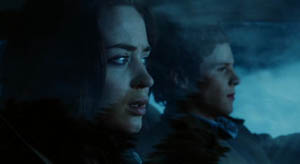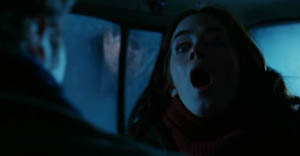|
The horror/thriller genre is one in desperate need of some new blood, no pun intended. Few others are so shamelessly formulaic and repetitive, though the paradigm does shift every ten years or so, ultimately doing little beyond creating a new formula to be endlessly parroted for years to come. The 1970s had its fill of Satan movies, the 1980s went the slasher route, and this past decade has indulged itself in endless iterations of repugnant torture films, which I've zero desire to see. I far prefer a more traditional ghost tale, despite having no actual belief in such things. Wind Chill does attempt to return to this more psychological territory, and for that, at least, I'm grateful. 
A college girl accepts a ride from a fellow student when she finds herself in need of transportation home for Christmas break. He's awkward and fumbling, she's aloof and not very personable. Neither are ever called by name within the duration of the film. As they trek across the snow-covered country, it slowly becomes evident that the boy has deceived the girl to some extent regarding his motives. Before this can be cleared up, a passing car runs the pair off of the road and into a snowdrift, where much of the remainder of the film will play out. There's something intriguing and fascinating about spatial minimalism in a film, if only because it's so audacious: it's precisely the sort of thing that can not only fail, but fail quite spectacularly. Seeing it attempted, therefore, gives the impression that the director has confidence in his own abilities. For at least half of its rather short (roughly an hour and a half) running time, I was reasonably convinced, as well. There are some very effective moments in the half-snowbound car where we the audience see, or partly see, things moving in the background that the characters do not. This is, as defined by Hitchcock, suspense incarnate. Something leaping out of the dark is shock; effective for a brief moment, perhaps, but hardly interesting. A threat (or potential threat) seen by us but not by the protagonists is suspense. The unknown, be it mysterious figures who shuffle by in the dark and seem uninterested in rendering aid or simply the seeming illogic of our situation, is what creates lasting tension. Knowing that we face an axe-wielding maniac is only suspenseful in those instances wherein we can anticipate him leaping from the dark. This part of the film, the more restrained part, is effective. However, things begin to get wobbly with the arrival of an aggressive highway patrolman who presents an uncertain yet definite threat. The scene climaxes with the use of a visual effect so out of place with the previously established low-key style that for the next minute or so I was almost convinced that the scene was meant to have been a dream. There are a few more good scenes after this, but the film can't quite deliver on the hopes it at first instilled. 
Ghost movies often have the problem of trying to build mystery around why a haunting occurs, when there's generally exactly one reason, with minor changes in details. Stories like The Shining and The Haunting (the original) sidestep this problem by getting the issue out of the way up front: the location has long been a repository of bad events. "Why" isn't really important unless it somehow helps with the true matter of significance: survival. Wind Chill, regrettably, gets bogged down by exposition in its final act. To its credit, it does not end the way in which far too many such films end. About fifteen minutes in, after an odd incident at a gas station which itself immediately followed an entirely too obviously topical conversation, I was convinced I knew how things would play out. I was thankfully wrong on several points, but was then confused as to what the gas station scene, where the girl receives many creepy stares and is unaccountably incapable of reopening the restroom door, could have possibly meant instead. Other little details, like the notable absence of any license plates on the boy's car, seem as if they should denote something of significance, but likewise go unexplained. I would frankly far rather see a baker's dozen films of this ilk than one more entry in the Saw series, but writers and directors really need to start finding better ways of concluding these affairs. Kudos to Gregory Jacobs for not giving me the ending I predicted, but several points off for providing one with nearly no thrills after such an effective setup. -review by Matt Murray
|
|
||||||||